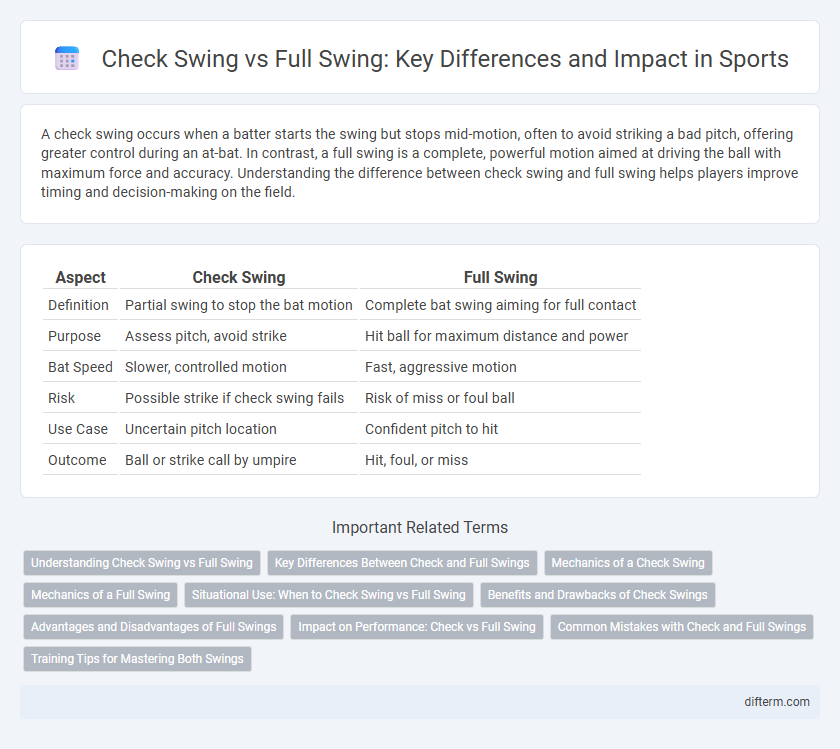A check swing occurs when a batter starts the swing but stops mid-motion, often to avoid striking a bad pitch, offering greater control during an at-bat. In contrast, a full swing is a complete, powerful motion aimed at driving the ball with maximum force and accuracy. Understanding the difference between check swing and full swing helps players improve timing and decision-making on the field.
Table of Comparison
| Aspect | Check Swing | Full Swing |
|---|---|---|
| Definition | Partial swing to stop the bat motion | Complete bat swing aiming for full contact |
| Purpose | Assess pitch, avoid strike | Hit ball for maximum distance and power |
| Bat Speed | Slower, controlled motion | Fast, aggressive motion |
| Risk | Possible strike if check swing fails | Risk of miss or foul ball |
| Use Case | Uncertain pitch location | Confident pitch to hit |
| Outcome | Ball or strike call by umpire | Hit, foul, or miss |
Understanding Check Swing vs Full Swing
A check swing occurs when a batter starts a full swing but stops midway to avoid striking the ball, often used to prevent striking at a bad pitch or a ball outside the strike zone. In contrast, a full swing involves a complete, powerful motion aimed at making solid contact with the ball to maximize distance and control. Understanding the mechanics and strategic use of both swings enhances a player's ability to react effectively to different pitches in baseball or softball.
Key Differences Between Check and Full Swings
The key differences between check swings and full swings lie in the range of motion and intent; check swings involve a partial, controlled rotation of the wrists and hips to halt the swing mid-action, while full swings execute a complete, fluid motion to maximize bat speed and power. Check swings are primarily used to avoid striking a pitch outside the strike zone, emphasizing precision and quick reflexes, contrasting with the full swing's focus on driving the ball aggressively. Biomechanically, full swings generate greater angular velocity and kinetic energy transfer, resulting in longer ball flight compared to the restrained movement of check swings.
Mechanics of a Check Swing
The mechanics of a check swing involve a rapid deceleration of the bat's motion midway through the swing to prevent the ball from being hit, relying on strong wrist control and precise timing. Unlike a full swing that generates maximum power and bat speed, a check swing emphasizes smaller muscle groups in the forearms and requires excellent proprioception to stop the bat effectively. Proper execution reduces strikeouts and allows batters to protect the plate while avoiding poor contact or fouls.
Mechanics of a Full Swing
The mechanics of a full swing in sports like golf or baseball involve a coordinated sequence of movements that maximize power and control. Key elements include a strong grip, proper stance, weight transfer from the back foot to the front foot, and a full rotation of the hips and shoulders to generate momentum. This engine-like motion ensures optimal bat or club speed and accurate contact with the ball, differentiating it clearly from the restricted motion of a check swing.
Situational Use: When to Check Swing vs Full Swing
A check swing is ideal when a hitter senses a pitch outside the strike zone or aims to avoid striking out, allowing timely restraint to prevent a bad swing. A full swing is necessary when confidently recognizing a strike or a pitch in the hitting zone, maximizing power and contact potential. Understanding pitcher tendencies and game context refines the decision between a cautious check swing and an aggressive full swing for optimal batting strategy.
Benefits and Drawbacks of Check Swings
Check swings offer the benefit of allowing a batter to control their swing mid-motion, helping to avoid striking at balls outside the strike zone and reducing the risk of weak contact. This technique can save at-bats and prevent unnecessary outs but may lead to interference calls if the umpire judges the swing as a full attempt. While check swings enhance strategic decision-making, their effectiveness depends heavily on the batter's timing and ability to quickly stop the swing without compromising balance.
Advantages and Disadvantages of Full Swings
Full swings generate maximum power and distance, making them ideal for driving the ball long distances in baseball and golf. However, they require precise timing and proper technique to avoid strain and reduce the risk of injury. While full swings offer greater impact force, they sacrifice control and accuracy compared to more controlled swings like the check swing.
Impact on Performance: Check vs Full Swing
Check swings allow for greater control and quicker adjustments, enhancing shot accuracy and reducing the risk of overhitting in sports like golf and baseball. Full swings generate more power and distance but often sacrifice precision, making them ideal for aggressive play when accuracy is less critical. Understanding the impact of check versus full swings helps athletes balance power and control to optimize overall performance.
Common Mistakes with Check and Full Swings
Common mistakes with a check swing include poor timing and incomplete follow-through, often leading to weak contact or a foul ball. Full swing errors frequently involve over-committing or improper weight transfer, resulting in loss of balance and reduced power. Consistent practice and focus on mechanics help correct these issues for more effective at-bats.
Training Tips for Mastering Both Swings
Mastering check swing and full swing requires targeted drills that enhance timing, control, and power. Incorporate bat speed exercises, swing plane analysis, and situational simulation training to develop muscle memory for both swing types. Consistent video feedback and professional coaching accelerate improvement and ensure proper mechanics for optimal performance.
check swing vs full swing Infographic

 difterm.com
difterm.com